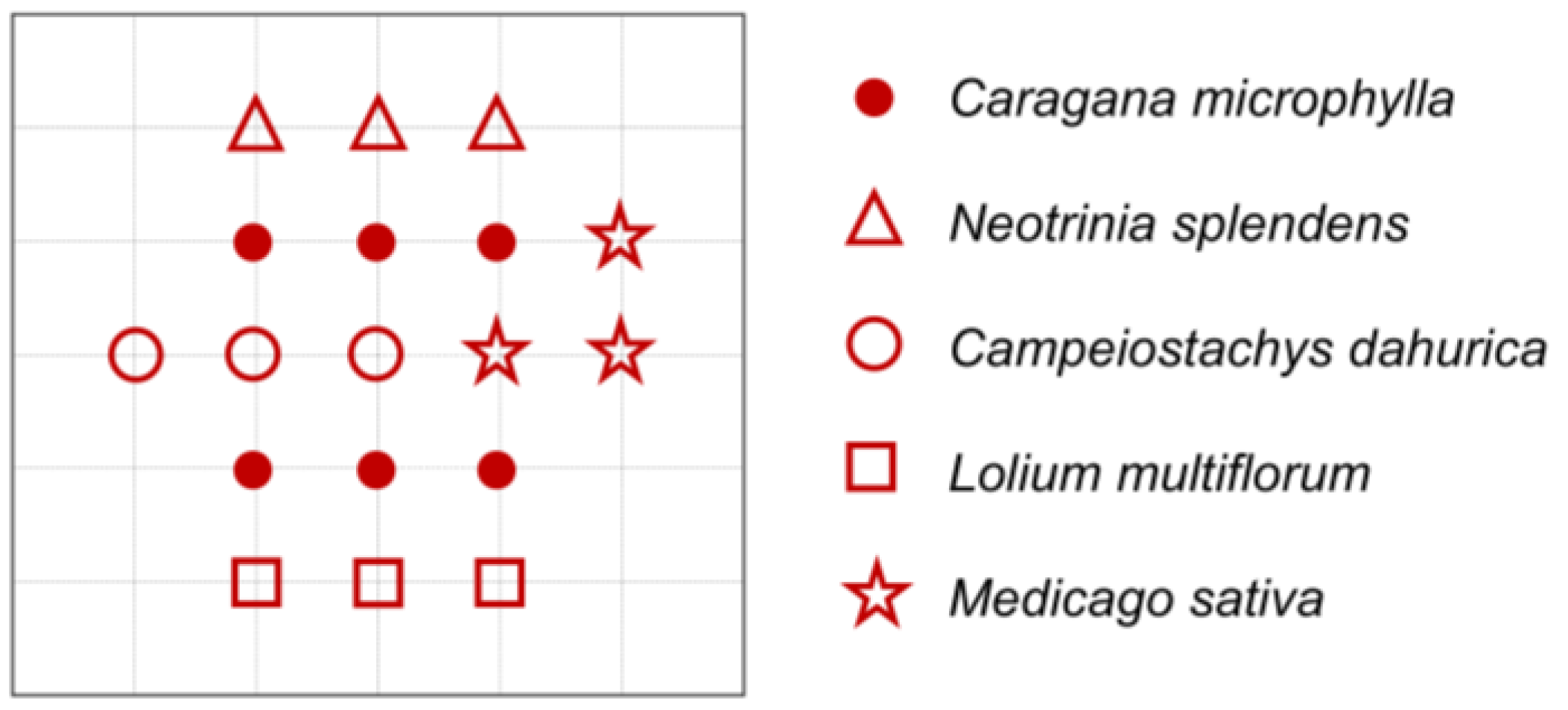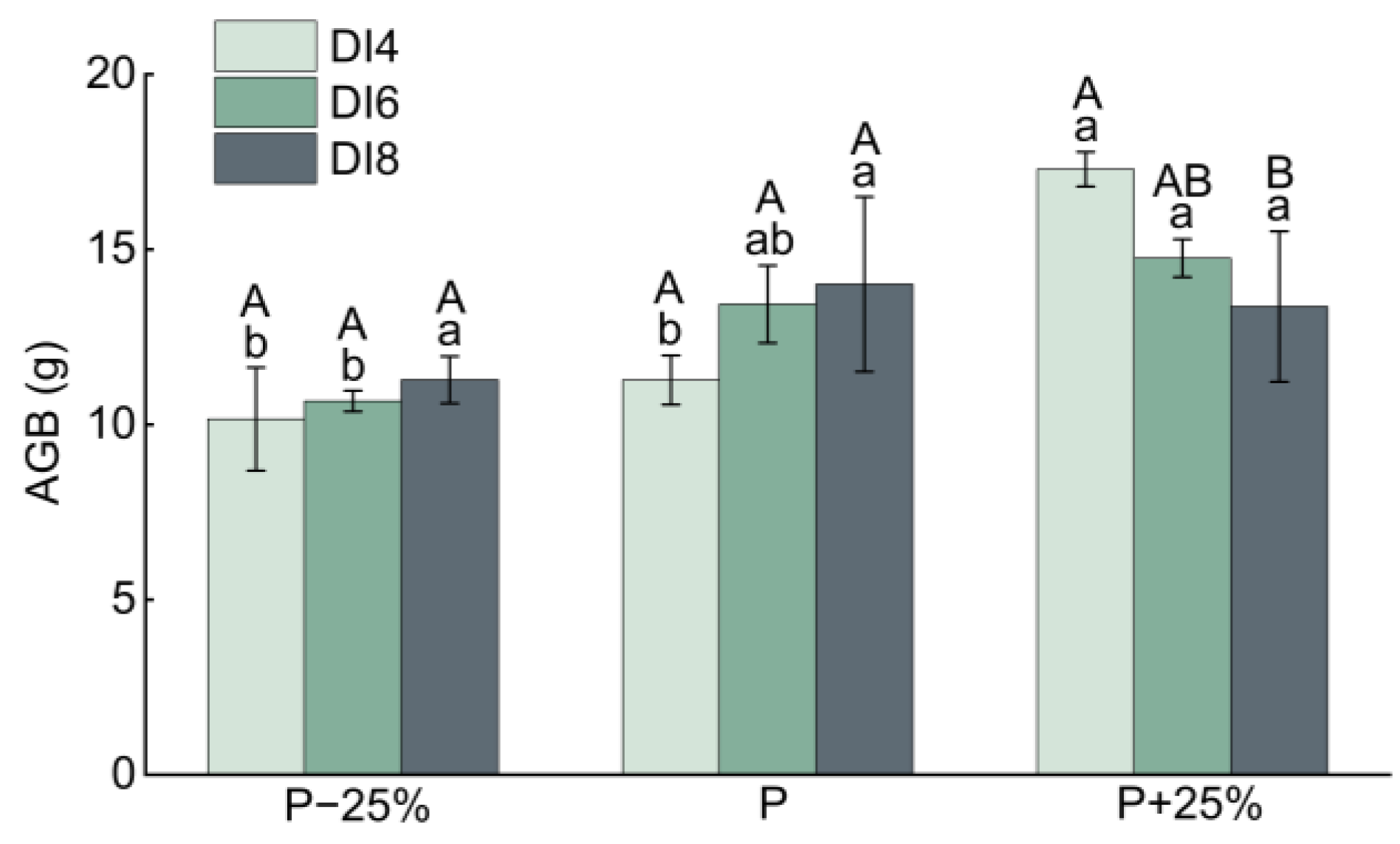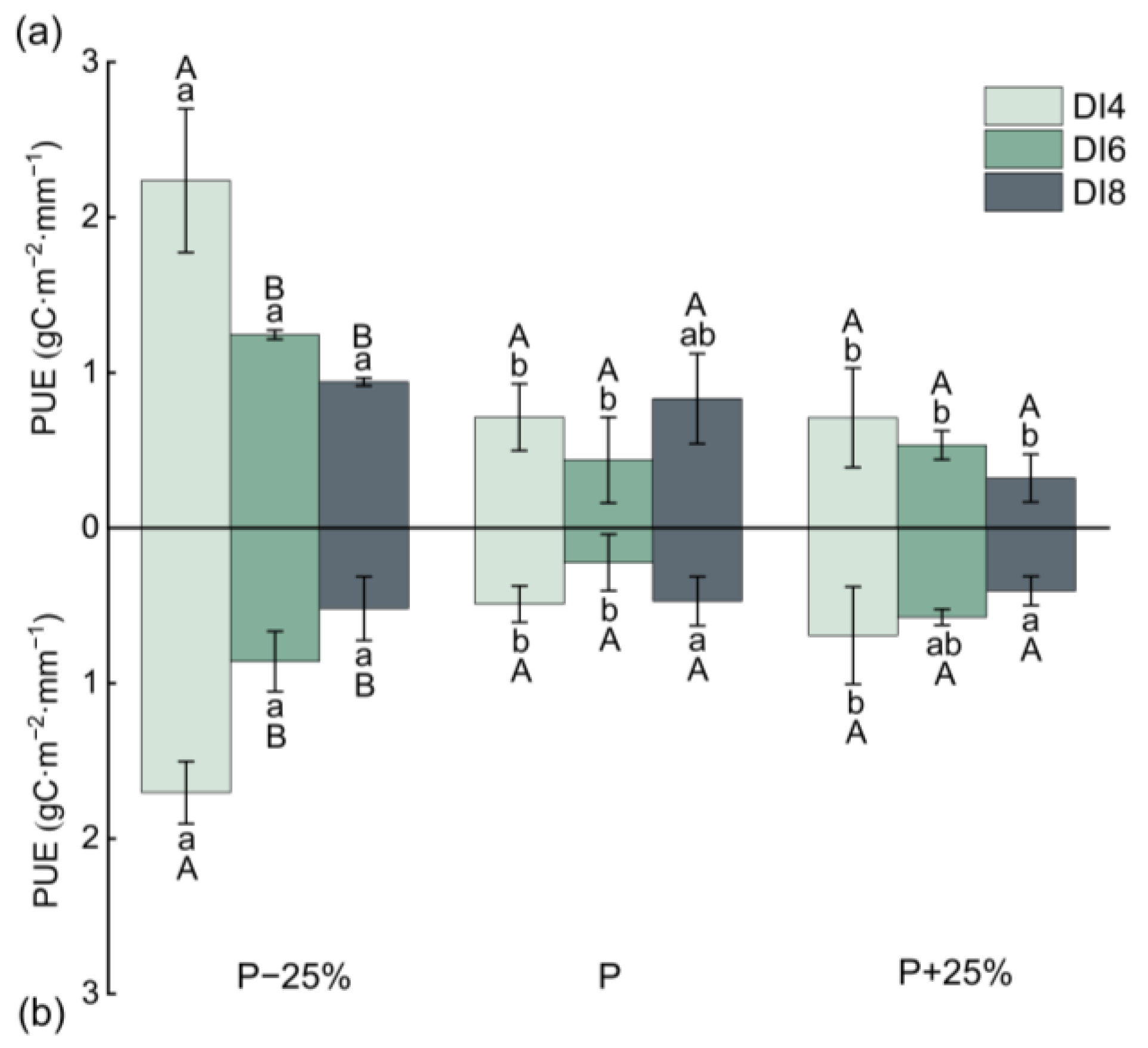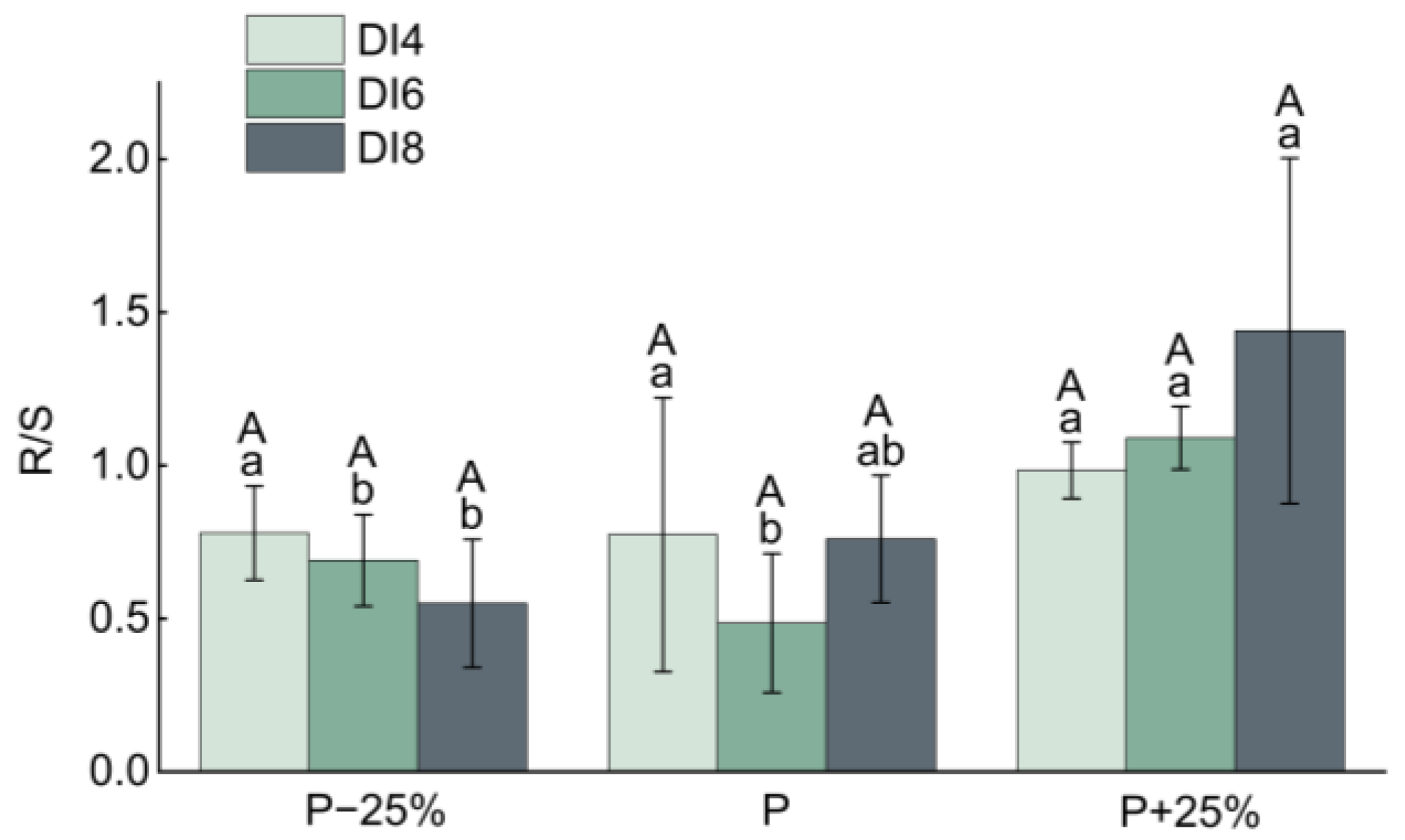Caragana microphylla (Shrub) Seedlings Exhibit Better Growth than Surrounding Herbs Under Drought Conditions
Abstract
1. Introduction
2. Materials and Methods
2.1. Experimental Design
2.2. Measurement Indicators and Methods
2.2.1. Measurement of Leaf Water Potential
2.2.2. Measurement of Net Photosynthetic Rate
2.2.3. Determination of Biomass Parameters
2.3. Data Processing and Analysis
3. Results
3.1. Ecophysiological Responses
3.1.1. Leaf Water Potential
3.1.2. Net Photosynthetic Rate
3.2. Growth Responses
3.2.1. Plant Height
3.2.2. Biomass
3.2.3. Precipitation Use Efficiency
3.2.4. Root–Shoot Ratio
4. Discussion
4.1. Reduced Rainfall Boosts Shrub Growth Whereas Increased Has Little Impact
4.2. Extended Drought Intervals Benefit Shrub Growth
4.3. Shrub Encroachment Trend Under Future Rainfall Regimes
5. Conclusions
Author Contributions
Funding
Institutional Review Board Statement
Informed Consent Statement
Data Availability Statement
Conflicts of Interest
References
- Van Auken, O.W. Shrub Invasions of North American Semiarid Grasslands. Annu. Rev. Ecol. Syst. 2000, 31, 197–215. [Google Scholar] [CrossRef]
- Deng, Y.; Li, X.; Shi, F.; Hu, X. Woody Plant Encroachment Enhanced Global Vegetation Greening and Ecosystem Water-use Efficiency. Glob. Ecol. Biogeogr. 2021, 30, 2337–2353. [Google Scholar] [CrossRef]
- Eldridge, D.J.; Bowker, M.A.; Maestre, F.T.; Roger, E.; Reynolds, J.F.; Whitford, W.G. Impacts of Shrub Encroachment on Ecosystem Structure and Functioning: Towards a Global Synthesis: Synthesizing Shrub Encroachment Effects. Ecol. Lett. 2011, 14, 709–722. [Google Scholar] [CrossRef] [PubMed]
- Chen, L.; Li, H.; Zhang, P.; Zhao, X.; Zhou, L.; Liu, T.; Hu, H.; Bai, Y.; Shen, H.; Fang, J. Climate and Native Grassland Vegetation as Drivers of the Community Structures of Shrub-Encroached Grasslands in Inner Mongolia, China. Landsc. Ecol. 2015, 30, 1627–1641. [Google Scholar] [CrossRef]
- Peng, H.; Li, X.; Li, G.; Zhang, Z.; Zhang, S.; Li, L.; Zhao, G.; Jiang, Z.; Ma, Y. Shrub Encroachment with Increasing Anthropogenic Disturbance in the Semiarid Inner Mongolian Grasslands of China. CATENA 2013, 109, 39–48. [Google Scholar] [CrossRef]
- Zhang, A.; Chen, S.; Chen, J.; Cui, H.; Jiang, X.; Xiao, S.; Wang, J.; Gao, H.; An, L.; Cardoso, P. Shrub and Precipitation Interactions Shape Functional Diversity of Nematode Communities on the Qinghai–Tibet Plateau. Glob. Change Biol. 2023, 29, 2746–2758. [Google Scholar] [CrossRef]
- Liu, Y.; Zhang, Z.; Liu, Y.; Cui, Z.; Leite, P.A.M.; Shi, J.; Wang, Y.; Wu, G. Shrub Encroachment Enhances the Infiltration Capacity of Alpine Meadows by Changing the Community Composition and Soil Conditions. CATENA 2022, 213, 106222. [Google Scholar] [CrossRef]
- Zhang, Z.; Li, X.; Yang, X.; Shi, Y.; Zhang, S.; Jiang, Z. Changes in Soil Properties Following Shrub Encroachment in the Semiarid Inner Mongolian Grasslands of China. Soil Sci. Plant Nutr. 2020, 66, 369–378. [Google Scholar] [CrossRef]
- Cao, X.; Liu, Y.; Cui, X.; Chen, J.; Chen, X. Mechanisms, Monitoring and Modeling of Shrub Encroachment into Grassland: A Review. Int. J. Digit. Earth 2019, 12, 625–641. [Google Scholar] [CrossRef]
- D’Odorico, P.; Okin, G.S.; Bestelmeyer, B.T. A Synthetic Review of Feedbacks and Drivers of Shrub Encroachment in Arid Grasslands. Ecohydrology 2012, 5, 520–530. [Google Scholar] [CrossRef]
- Fan, Y.; Li, X.; Huang, Y.; Li, L.; Zhang, J.; Liu, Q.; Jiang, Z. Shrub Patch Configuration in Relation to Precipitation and Soil Properties in Northwest China. Ecohydrology 2018, 11, e1916. [Google Scholar] [CrossRef]
- Masson-Delmotte, V.; Zhai, P.; Pirani, A.; Connors, S.L.; Péan, C.; Berger, S.; Caud, N.; Chen, Y.; Goldfarb, L.; Gomis, M.I.; et al. (Eds.) IPCC (2021) Climate Change 2021: The Physical Science Basis. Contribution of Working Group I to the Sixth Assessment Report of the Intergovernmental Panel on Climate Change; Cambridge University Press: Cambridge, UK; New York, NY, USA, 2021; pp. 1–2391. [Google Scholar] [CrossRef]
- Core Writing Team; Lee, H.; Romero, J. (Eds.) IPCC (2023) Climate Change 2023: Synthesis Report. Contribution of Working Groups I, II and III to the Sixth Assessment Report of the Intergovernmental Panel on Climate Change; IPCC: Geneva, Switzerland, 2023; pp. 35–115. [Google Scholar] [CrossRef]
- Shen, L.; Zhang, F.; Huang, J.; Li, Y.; Ling, Y. Spatiotemporal Variations of Different Precipitation Grades in Inner Mongolia from 1981 to 2018. J. Meteorol. Sci. 2022, 42, 162–170. (In Chinese) [Google Scholar] [CrossRef]
- Li, Y.; Tong, S.; Bao, Y.; Guo, E.; Bao, Y. Prediction of Droughts in the Mongolian Plateau Based on the CMIP5 Model. Water 2020, 12, 2774. [Google Scholar] [CrossRef]
- Kulmatiski, A.; Beard, K.H. Woody Plant Encroachment Facilitated by Increased Precipitation Intensity. Nat. Clim. Change 2013, 3, 833–837. [Google Scholar] [CrossRef]
- Throop, H.L.; Reichmann, L.G.; Sala, O.E.; Archer, S.R. Response of Dominant Grass and Shrub Species to Water Manipulation: An Ecophysiological Basis for Shrub Invasion in a Chihuahuan Desert Grassland. Oecologia 2012, 169, 373–383. [Google Scholar] [CrossRef]
- Staver, A.C.; Archibald, S.; Levin, S.A. The Global Extent and Determinants of Savanna and Forest as Alternative Biome States. Science 2011, 334, 230–232. [Google Scholar] [CrossRef]
- Zhu, Y.; Shen, H.; Akinyemi, D.S.; Zhang, P.; Feng, Y.; Zhao, M.; Kang, J.; Zhao, X.; Hu, H.; Fang, J. Increased Precipitation Attenuates Shrub Encroachment by Facilitating Herbaceous Growth in a Mongolian Grassland. Funct. Ecol. 2022, 36, 2356–2366. [Google Scholar] [CrossRef]
- Báez, S.; Collins, S.L.; Pockman, W.T.; Johnson, J.E.; Small, E.E. Effects of Experimental Rainfall Manipulations on Chihuahuan Desert Grassland and Shrubland Plant Communities. Oecologia 2013, 172, 1117–1127. [Google Scholar] [CrossRef]
- Heisler-White, J.L.; Blair, J.M.; Kelly, E.F.; Harmoney, K.; Knapp, A.K. Contingent Productivity Responses to More Extreme Rainfall Regimes across a Grassland Biome. Glob. Change Biol. 2009, 15, 2894–2904. [Google Scholar] [CrossRef]
- Knapp, A.K.; Beier, C.; Briske, D.D.; Classen, A.T.; Luo, Y.; Reichstein, M.; Smith, M.D.; Smith, S.D.; Bell, J.E.; Fay, P.A.; et al. Consequences of More Extreme Precipitation Regimes for Terrestrial Ecosystems. BioScience 2008, 58, 811–821. [Google Scholar] [CrossRef]
- Maestre, F.T.; Reynolds, J.F. Amount or Pattern? Grassland Responses to the Heterogeneity and Availability of Two Key Resources. Ecology 2007, 88, 501–511. [Google Scholar] [CrossRef] [PubMed]
- Yu, M.; He, Y.; Zhang, F.; Ding, G.; Wang, C. Effects of Intra-Year Precipitation Variability on Shrub Community Productivity Depend on the Annual Total Rainfall. Plant Soil 2023, 487, 499–510. [Google Scholar] [CrossRef]
- Gao, S.; Liu, J.; Chang, Y. Trend Analysis of Seasonal and Annual Precipitation in Inner Mongolia. Torrential Rain Disasters 2022, 41, 426–433. (In Chinese) [Google Scholar]
- Hu, S.; Mo, X.; Lin, Z. Temporal and spatial changing trends of drought in northern my country under future climate scenarios. Arid Land Geogr. 2015, 38, 239–248. (In Chinese) [Google Scholar]
- Zhang, X.; Zhao, W.; Liu, Y.; Fang, X.; Feng, Q. The Relationships between Grasslands and Soil Moisture on the Loess Plateau of China: A Review. CATENA 2016, 145, 56–67. [Google Scholar] [CrossRef]
- Rysavy, A.; Seifan, M.; Sternberg, M.; Tielbörger, K. Shrub Seedling Survival under Climate Change—Comparing Natural and Experimental Rainfall Gradients. J. Arid. Environ. 2014, 111, 14–21. [Google Scholar] [CrossRef]
- Johnson, I.R.; Thornley, J.H.M. A Model of Shoot: Root Partitioning with Optimal Growth. Ann. Bot. 1987, 60, 133–142. [Google Scholar] [CrossRef]
- Reynolds, J.F.; Thornley, J.H.M. A Shoot: Root Partitioning Model. Ann. Bot. 1982, 49, 585–597. [Google Scholar] [CrossRef]
- Ledo, A.; Paul, K.I.; Burslem, D.F.R.P.; Ewel, J.J.; Barton, C.; Battaglia, M.; Brooksbank, K.; Carter, J.; Eid, T.H.; England, J.R.; et al. Tree Size and Climatic Water Deficit Control Root to Shoot Ratio in Individual Trees Globally. New Phytol. 2018, 217, 8–11. [Google Scholar] [CrossRef]
- Huang, L.; Zhang, Z. Effect of Rainfall Pulses on Plant Growth and Transpiration of Two Xerophytic Shrubs in a Revegetated Desert Area: Tengger Desert, China. CATENA 2016, 137, 269–276. [Google Scholar] [CrossRef]
- De Micco, V.; Aronne, G. Anatomy and Lignin Characterisation of Twigs in the Chaparral Shrub Rhamnus Californica. IAWA J. 2012, 33, 151–162. [Google Scholar] [CrossRef]
- Lambers, H.; Oliveira, R.S. Plant Physiological Ecology; Springer International Publishing: Cham, Switzerland, 2019; ISBN 978-3-030-29638-4. [Google Scholar]
- Bestelmeyer, B.T.; Peters, D.P.C.; Archer, S.R.; Browning, D.M.; Okin, G.S.; Schooley, R.L.; Webb, N.P. The Grassland–Shrubland Regime Shift in the Southwestern United States: Misconceptions and Their Implications for Management. BioScience 2018, 68, 678–690. [Google Scholar] [CrossRef]
- Cheng, X.; An, S.; Li, B.; Chen, J.; Lin, G.; Liu, Y.; Luo, Y.; Liu, S. Summer Rain Pulse Size and Rainwater Uptake by Three Dominant Desert Plants in a Desertified Grassland Ecosystem in Northwestern China. Plant Ecol. 2006, 184, 1–12. [Google Scholar] [CrossRef]
- Weltzin, J.F.; Loik, M.E.; Schwinning, S.; Williams, D.G.; Fay, P.A.; Haddad, B.M.; Harte, J.; Huxman, T.E.; Knapp, A.K.; Lin, G.; et al. Assessing the Response of Terrestrial Ecosystems to Potential Changes in Precipitation. BioScience 2003, 53, 941. [Google Scholar] [CrossRef]
- Austin, A.T.; Yahdjian, L.; Stark, J.M.; Belnap, J.; Porporato, A.; Norton, U.; Ravetta, D.A.; Schaeffer, S.M. Water Pulses and Biogeochemical Cycles in Arid and Semiarid Ecosystems. Oecologia 2004, 141, 221–235. [Google Scholar] [CrossRef] [PubMed]
- Xiong, P.; Shu, J.; Zhang, H.; Jia, Z.; Song, J.; Palta, J.A.; Xu, B. Small Rainfall Pulses Affected Leaf Photosynthesis Rather than Biomass Production of Dominant Species in Semiarid Grassland Community on Loess Plateau of China. Funct. Plant Biol. 2017, 44, 1229. [Google Scholar] [CrossRef]
- Feldman, A.F.; Feng, X.; Felton, A.J.; Konings, A.G.; Knapp, A.K.; Biederman, J.A.; Poulter, B. Plant Responses to Changing Rainfall Frequency and Intensity. Nat. Rev. Earth Environ. 2024, 5, 276–294. [Google Scholar] [CrossRef]
- Kulmatiski, A.; Holdrege, M.C.; Chirvasă, C.; Beard, K.H. Root Distributions Predict Shrub–Steppe Responses to Precipitation Intensity. Biogeosciences 2024, 21, 131–143. [Google Scholar] [CrossRef]
- Guo, J.; Gong, X.; Fang, L.; Jiang, D.; Ala, M.; Bucci, S.J.; Scholz, F.G.; Goldstein, G.; Hao, G. Switching of Dominant Positions between Two Sand-fixing Shrub Species during the Dune Revegetation Process Is Underlain by Their Contrasting Xylem Hydraulics and Water-use Strategies. Land Degrad. Dev. 2020, 31, 1195–1205. [Google Scholar] [CrossRef]
- Knapp, A.K.; Hoover, D.L.; Wilcox, K.R.; Avolio, M.L.; Koerner, S.E.; La Pierre, K.J.; Loik, M.E.; Luo, Y.; Sala, O.E.; Smith, M.D. Characterizing Differences in Precipitation Regimes of Extreme Wet and Dry Years: Implications for Climate Change Experiments. Glob. Change Biol. 2015, 21, 2624–2633. [Google Scholar] [CrossRef]
- Li, S.; Chen, Y.; Wei, W.; Fang, G.; Duan, W. The Increase in Extreme Precipitation and Its Proportion over Global Land. J. Hydrol. 2024, 628, 130456. [Google Scholar] [CrossRef]
- Ma, S.; Zhou, T.; Dai, A.; Han, Z. Observed Changes in the Distributions of Daily Precipitation Frequency and Amount over China from 1960 to 2013. J. Clim. 2015, 28, 6960–6978. [Google Scholar] [CrossRef]
- Kim, J.B.; So, J.M.; Bae, D.H. Global Warming Impacts on Severe Drought Characteristics in Asia Monsoon Region. Water 2020, 12, 1360. [Google Scholar] [CrossRef]
- Luo, W.; Zuo, X.; Griffin-Nolan, R.J.; Xu, C.; Ma, W.; Song, L.; Helsen, K.; Lin, Y.; Cai, J.; Yu, Q.; et al. Long Term Experimental Drought Alters Community Plant Trait Variation, Not Trait Means, across Three Semiarid Grasslands. Plant Soil 2019, 442, 343–353. [Google Scholar] [CrossRef]










| Precipitation Amount | P−25% (225 mm) | P (300 mm) | P+25% (375 mm) | |
|---|---|---|---|---|
| Drought Interval | ||||
| DI4 | 151 mL | 200 mL | 250 mL | |
| DI6 | 225 mL | 299 mL | 376 mL | |
| DI8 | 299 mL | 401 mL | 500 mL | |
| Variable | Species | P | DI | P × DI | |||
|---|---|---|---|---|---|---|---|
| F | Sig. | F | Sig. | F | Sig. | ||
| Pre-watering ΨL (MPa) | C. microphylla | 4.041 | 0.036 * | 2.490 | 0.111 | 1.423 | 0.267 |
| C. dahurica | 0.588 | 0.566 | 10.928 | <0.001 *** | 0.750 | 0.571 | |
| Post-watering ΨL (Mpa) | C. microphylla | 1.227 | 0.317 | 4.422 | 0.027 * | 2.908 | 0.051 |
| C. dahurica | 1.310 | 0.294 | 3.980 | 0.037 * | 1.950 | 0.146 | |
| Pn (μmolCO2·m−2·s−1) | C. microphylla | 14.912 | <0.001 *** | 0.161 | 0.853 | 4.505 | 0.017* |
| C. dahurica | 11.715 | 0.001 ** | 0.049 | 0.952 | 0.507 | 0.732 | |
| Aboveground PUE (gC·m−2·mm−1) | C. microphylla | 42.183 | <0.001 *** | 13.204 | <0.001 *** | 6.983 | 0.002 ** |
| four herbs | 4.531 | 0.025 * | 106.285 | <0.001 *** | 4.482 | 0.011 * | |
| Belowground PUE (gC·m−2·mm−1) | C. microphylla | 28.955 | <0.001 *** | 18.897 | <0.001 *** | 9.138 | <0.001 *** |
| AGB (g) | C. microphylla | 11.233 | <0.001 *** | 2.042 | 0.160 | 4.610 | 0.011 * |
| four herbs | 25.181 | <0.001 *** | 0.006 | 0.994 | 5.418 | 0.005 ** | |
| BGB (g) | C. microphylla | 7.849 | 0.004 ** | 0.529 | 0.598 | 3.894 | 0.019 * |
| TB (g) | C. microphylla | 7.464 | 0.005 ** | 1.872 | 0.184 | 5.572 | 0.005 ** |
| R/S | C. microphylla | 9.533 | 0.002 ** | 0.288 | 0.753 | 1.416 | 0.271 |
| Plant height (cm) | C. microphylla | 3.535 | 0.051 | 0.258 | 0.775 | 1.362 | 0.286 |
| N. splendens | 9.808 | 0.002 ** | 1.686 | 0.216 | 0.290 | 0.880 | |
| C. dahurica | 16.533 | <0.001 *** | 4.961 | 0.019 * | 2.329 | 0.095 | |
| L. multiflorum | 13.815 | <0.001 *** | 2.327 | 0.126 | 2.877 | 0.053 | |
| M. sativa | 2.261 | 0.133 | 0.496 | 0.617 | 0.525 | 0.718 | |
Disclaimer/Publisher’s Note: The statements, opinions and data contained in all publications are solely those of the individual author(s) and contributor(s) and not of MDPI and/or the editor(s). MDPI and/or the editor(s) disclaim responsibility for any injury to people or property resulting from any ideas, methods, instructions or products referred to in the content. |
© 2025 by the authors. Licensee MDPI, Basel, Switzerland. This article is an open access article distributed under the terms and conditions of the Creative Commons Attribution (CC BY) license (https://creativecommons.org/licenses/by/4.0/).
Share and Cite
Wang, Z.; Tu, C.; Fan, J.; Wu, C.; Lv, Z.; Liu, R.; Fan, Y. Caragana microphylla (Shrub) Seedlings Exhibit Better Growth than Surrounding Herbs Under Drought Conditions. Sustainability 2025, 17, 1142. https://doi.org/10.3390/su17031142
Wang Z, Tu C, Fan J, Wu C, Lv Z, Liu R, Fan Y. Caragana microphylla (Shrub) Seedlings Exhibit Better Growth than Surrounding Herbs Under Drought Conditions. Sustainability. 2025; 17(3):1142. https://doi.org/10.3390/su17031142
Chicago/Turabian StyleWang, Zhengyu, Chengyi Tu, Jingjing Fan, Chuchen Wu, Zhenglin Lv, Ruining Liu, and Ying Fan. 2025. "Caragana microphylla (Shrub) Seedlings Exhibit Better Growth than Surrounding Herbs Under Drought Conditions" Sustainability 17, no. 3: 1142. https://doi.org/10.3390/su17031142
APA StyleWang, Z., Tu, C., Fan, J., Wu, C., Lv, Z., Liu, R., & Fan, Y. (2025). Caragana microphylla (Shrub) Seedlings Exhibit Better Growth than Surrounding Herbs Under Drought Conditions. Sustainability, 17(3), 1142. https://doi.org/10.3390/su17031142





